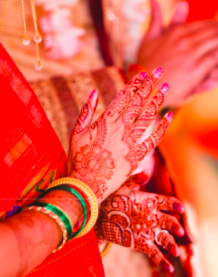Henna ~ The Meter Of Love
5/19/2018
Henna is a plant under the botanical name: Lawsonia Inermis, which is found grown in India, South Asian and North African countries. Natural Henna is made with dry leaves mixed with hot water, lemon, sugar and some natural oils. The mixture is then transferred into a small plastic tube with a fine point to allow for intricate designs. Applied on the skin it is slightly raised and once absorbed by the body it is completely dry. As a few hours pass, it begins to flake off of the skin leaving an impression of the design created by the artist. At first it is a light orange in color, then darkens to brown within thirty-six hours. Staying a dark color for several days, it begins to fade and will disappear in about three weeks.
Being highly antiseptic, its use was encouraged early on to help relieve the worry of contracting a viral disease during the stressful time of the wedding preparation. It evolved into an important facet of Hindu and Sikh weddings, and is applied during the wedding ceremonies on the bride, including family members and friends. It is believed that the body warmth of the individual will dictate the resultant coloring on the outer skin.
Folkloric beliefs orate the darker the Henna comes to the hand of the bride, the warmer her heart and the greater her love.
Henna plays a large role in the Indian festivals of Karva Chatuh, Eid and Diwali. Its popularity in Western countries began in the 1990's and is now often used as a temporary tattoo. Threading artists in the United States might use a variety of applications, some ingested with a dye to bring out different coloring. The natural color of Henna will always begin as a light orange, turning to a darker brown. A number of schools have formed to teach the art of applying Henna, and one knowledgeable in the art usually can identify the school by the patterns its students take into their practice after learning the art.
The better artists use only natural Henna ingredients shipped directly from India and some creatively design their patterns from their imaginative collection of designs, rather than follow the traditional patterns commonly found at salons. It is worthwhile noting in ones search for the artist that will provide them with an imaginative design using the best of the vegetable colored dyes.








